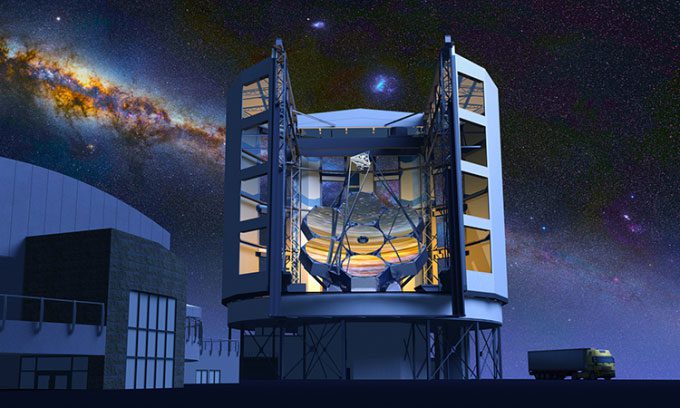The Giant Magellan Telescope is Under Construction in Chile and Will Provide Observations with Four Times the Resolution of the James Webb Space Telescope.
The Giant Magellan Telescope (GMT) Project has recently secured a significant investment of $205 million from the international GMTO Corporation to accelerate its construction. This funding marks one of the largest financing rounds for the telescope, including top commitments from Harvard University, the Carnegie Institution for Science, the São Paulo Research Foundation (FAPESP), the University of Texas at Austin, the University of Arizona, and the University of Chicago.

Simulation of the Giant Magellan Telescope upon completion. (Photo: Wikipedia)
According to Dr. Robert Shelton, the head of the GMT project, the new investment will be used to produce the telescope’s support structure at Ingersoll Machine Tools in Illinois, continue the development of seven primary mirrors at the Richard F. Caris Mirror Laboratory in Arizona, and fabricate one of the most advanced spectrographic instruments in Texas.
“This funding is truly a collaborative effort from the founding units. It will bring the telescope closer to first light and provide the world with transformative knowledge about the universe,” emphasized Dr. Eric Isaacs, President of the Carnegie Institution for Science, on August 2.
The Giant Magellan Telescope is being constructed at the Las Campanas Observatory in Chile. Once completed, it will enable scientists to look further into space with more detail than any previous optical telescope. The GMT will have a light-gathering area ten times larger and a resolution ten times higher than the James Webb Space Telescope.
The GMT will work in conjunction with Webb to power new scientific discoveries. It will represent the next step in the study of the faintest light sources in space identified by JWST. This includes searching for the atmospheres of potentially habitable planets, studying the first galaxies formed in the universe, and uncovering clues to illuminate the mysteries of dark matter, dark energy, black holes, and the formation of the universe.
The Giant Magellan Telescope, with a diameter of 25.4 meters, has made significant construction progress over the past few years. Six of its seven primary mirrors have been cast in Tucson, Arizona. The third primary mirror has completed a two-year polishing phase and is undergoing final testing. The construction of a 3,700 square meter facility in Illinois for producing the telescope’s support structure has also been completed. The production of the first adaptive secondary mirror is progressing well in France and Italy, while the site in Chile is being prepared for the next construction and foundation pouring phase.


















































